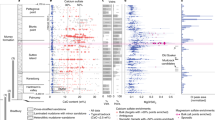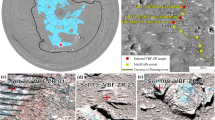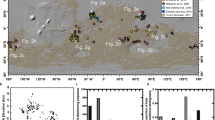Abstract
Grey haematite was recently detected in the Terra Meridiani region of Mars1,2 by the Thermal Emission Spectrometer onboard the Mars Global Surveyor spacecraft. The formation of haematite on Earth often requires liquid water to be present for long periods of time, making this an important target for deciphering the history of water on Mars. The Mars Exploration Rover Opportunity landed in Meridiani early in 2004 and has since discovered light-toned bedrock outcrops rich in chemical and textural signatures of long-term water interaction locally at the landing site3. Here I use remote sensing data to show that the light-toned outcrops at the landing site are not a local phenomenon. Instead, they are observable throughout the haematite-bearing plains in both visible and thermal infrared remote sensing data. Moreover, the light-toned material outcrops around much of the margin and is mappable for hundreds of kilometres to the north, east and west of the plains. I infer that 3 × 105 km2 of this material is exposed over 20° of longitude, indicating the extended presence of surface or near-surface water over a large region of Mars.
This is a preview of subscription content, access via your institution
Access options
Subscribe to this journal
Receive 51 print issues and online access
$199.00 per year
only $3.90 per issue
Buy this article
- Purchase on Springer Link
- Instant access to full article PDF
Prices may be subject to local taxes which are calculated during checkout




Similar content being viewed by others
References
Christensen, P. R. et al. Detection of crystalline hematite mineralization on Mars by the Thermal Emission Spectrometer: Evidence for near-surface water. J. Geophys. Res. 105, 9623–9642 (2000)
Christensen, P. R., Morris, R. V., Lane, M. D., Bandfield, J. L. & Malin, M. C. Global mapping of martian hematite mineral deposits: Remnants of water-driven processes on early Mars. J. Geophys. Res. 106, 23873–23886 (2001)
Squyres, S. W. et al. Initial results from the MER ATHENA science investigation at Gusev Crater and Meridiani Planum. Lunar Planet. Sci. Conf. XXXV, 2187 (2004)
Hynek, B. M., Arvidson, R. E. & Phillips, R. J. Geologic setting and origin of Terra Meridiani hematite deposit on Mars. J. Geophys. Res. 107, doi:10.1029/2002JE001891 (2002)
Lane, M. D., Christensen, P. R. & Hartmann, W. K. Utilization of the THEMIS visible and infrared imaging data for crater population studies of the Meridiani Planum landing site. Geophys. Res. Lett. 30, doi:10.1029/2003GL017183 (2003)
Edgett, K. S. & Malin, M. C. Martian sedimentary rock stratigraphy: Outcrops and interbedded craters of northwest Sinus Meridiani and southwest Arabia Terra. Geophys. Res. Lett. 29, doi:10.1029/2002GL016515 (2002)
Arvidson, R. E. et al. Mantled and exhumed terrains in Terra Meridiani, Mars. J. Geophys. Res. 108, doi:10.1029/2002JE001982 (2003)
Palluconi, F. D. & Kieffer, H. H. Thermal inertia mapping of Mars from 60 degrees S to 60 degrees N. Icarus 45, 415–426 (1981)
Mellon, M. T., Jakosky, B. M., Kieffer, H. H. & Christensen, P. R. High-resolution thermal inertia mapping from the Mars Global Surveyor Thermal Emission Spectrometer. Icarus 148, 437–455 (2000)
Tanaka, K. L. Dust and ice deposition in the martian geologic record. Icarus 144, 254–266 (2000)
Malin, M. C. & Edgett, K. S. Sedimentary rocks of early Mars. Science 290, 1927–1937 (2000)
Malin, M. C. & Edgett, K. S. Mars Global Surveyor Mars Orbiter Camera: Interplanetary cruise through primary mission. J. Geophys. Res. 106, 23429–23570 (2001)
Hynek, B. M., Phillips, R. J. & Arvidson, R. E. Explosive volcanism in the Tharsis region: Global evidence in the martian geologic record. J. Geophys. Res. 108, doi:10.1029/2003JE002062 (2003)
Hynek, B. M. et al. Thermophysical properties of Meridiani Planum, Mars. Lunar Planet. Sci. Conf. XXXV, 1899 (2004)
Christensen, P. R. et al. Mini-TES observations of the Gusev and Meridiani landing sites. Lunar Planet. Sci. Conf. XXXV, 2186 (2004)
Putzig, N. E. et al. Mars thermal inertia from THEMIS data. Lunar Planet. Sci. Conf. XXXV, 1863 (2004)
Jakosky, B. M. et al. Remote-sensing of the thermophysical properties of the MER and Beagle II landing sites on Mars. J. Geophys. Res. (submitted) (2004)
Acknowledgements
I thank N. E. Putzig and M. T. Mellon for THEMIS-derived thermal inertia products used in this study and B. M. Jakosky and J. R. Zimbelman for comments on this manuscript. This work was supported by the National Aeronautics and Space Agency (NASA).
Author information
Authors and Affiliations
Corresponding author
Ethics declarations
Competing interests
The authors declare that they have no competing financial interests.
Rights and permissions
About this article
Cite this article
Hynek, B. Implications for hydrologic processes on Mars from extensive bedrock outcrops throughout Terra Meridiani. Nature 431, 156–159 (2004). https://doi.org/10.1038/nature02902
Received:
Accepted:
Issue Date:
DOI: https://doi.org/10.1038/nature02902
This article is cited by
-
Karstic morphology in northern Sinus Meridiani, Mars
Geosciences Journal (2014)
-
Supervolcanoes within an ancient volcanic province in Arabia Terra, Mars
Nature (2013)
-
A thermogravimetric and infrared emission spectroscopic study of alunite
Journal of Thermal Analysis and Calorimetry (2008)
-
Meridiani Planum and the global hydrology of Mars
Nature (2007)
-
Identification and characterization of small RNAs from vernalizedArabidopsis thaliana
Journal of Plant Biology (2007)
Comments
By submitting a comment you agree to abide by our Terms and Community Guidelines. If you find something abusive or that does not comply with our terms or guidelines please flag it as inappropriate.



